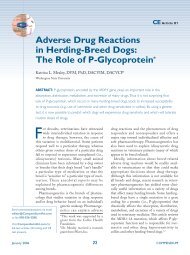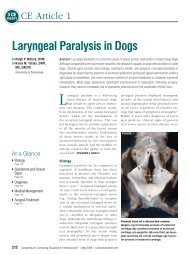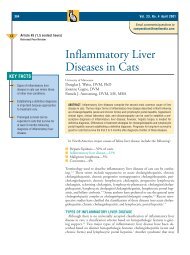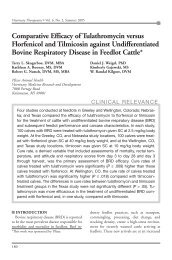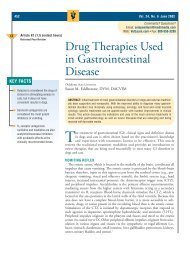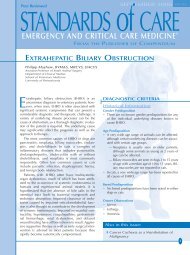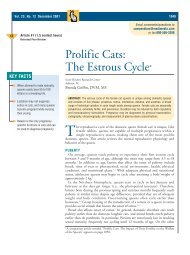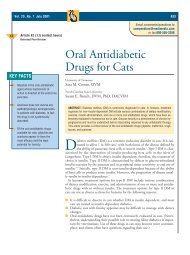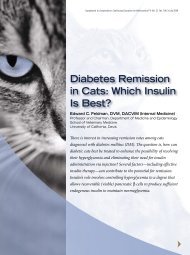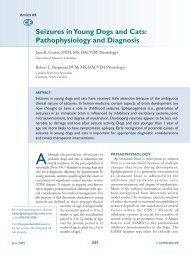Colloid Osmotic Pressure in Health and Disease* - VetLearn.com
Colloid Osmotic Pressure in Health and Disease* - VetLearn.com
Colloid Osmotic Pressure in Health and Disease* - VetLearn.com
Create successful ePaper yourself
Turn your PDF publications into a flip-book with our unique Google optimized e-Paper software.
904 Small Animal/Exotics Compendium October 2001<br />
ARTICLE<br />
CE<br />
#4 CE TEST<br />
The article you have read qualifies for 1.5 contact<br />
hours of Cont<strong>in</strong>u<strong>in</strong>g Education Credit from<br />
the Auburn University College of Veter<strong>in</strong>ary Med-<br />
ic<strong>in</strong>e. Choose the best answer to each of the follow-<br />
<strong>in</strong>g questions; then mark your answers on the<br />
postage-paid envelope <strong>in</strong>serted <strong>in</strong> Compendium.<br />
1. Intravascular COP<br />
a. is generated by <strong>in</strong>terstitial album<strong>in</strong> <strong>and</strong> other prote<strong>in</strong>s.<br />
b. preserves fluid with<strong>in</strong> the vasculature <strong>and</strong> opposes<br />
extravasation of fluid <strong>in</strong>to the <strong>in</strong>terstitium.<br />
c. is a negligible Starl<strong>in</strong>g force <strong>in</strong> biologic systems.<br />
d. is preserved despite losses of album<strong>in</strong> encountered<br />
<strong>in</strong> many different diseases.<br />
2. Starl<strong>in</strong>g’s equation<br />
a. can be accurately calculated us<strong>in</strong>g CVP <strong>and</strong> plasma.<br />
b. relates fluid shifts <strong>in</strong> terms of reflection <strong>and</strong> filtration<br />
coefficients.<br />
c. relates fluid flux as a difference <strong>in</strong> hydrostatic <strong>and</strong><br />
oncotic gradients found between the <strong>in</strong>travascular<br />
<strong>and</strong> <strong>in</strong>terstitial <strong>com</strong>partments.<br />
d. is the relationship of forces regulat<strong>in</strong>g fluid homeostasis<br />
<strong>and</strong> is constant among all organ systems.<br />
3. Album<strong>in</strong><br />
a. is the ma<strong>in</strong> contributor to COP.<br />
b. synthesis is solely regulated by hepatic COP.<br />
c. is <strong>com</strong>pletely impermeable through capillary membranes.<br />
d. is an acute-phase prote<strong>in</strong>, <strong>and</strong> its synthesis is <strong>in</strong>creased<br />
<strong>in</strong> response to <strong>in</strong>flammation.<br />
4. One rationale for adm<strong>in</strong>ister<strong>in</strong>g synthetic colloids is to<br />
<strong>in</strong>crease<br />
a. endogenous album<strong>in</strong> synthesis.<br />
b. lymphatic dra<strong>in</strong>age.<br />
c. plasma COP.<br />
d. total prote<strong>in</strong>.<br />
5. The Gibbs-Donnan effect<br />
a. refers to <strong>in</strong>creased membrane permeability due to<br />
<strong>in</strong>flammation.<br />
b. contributes to COP by attract<strong>in</strong>g immunoglobul<strong>in</strong>s<br />
<strong>and</strong> other osmotically active prote<strong>in</strong>s to album<strong>in</strong>.<br />
c. <strong>in</strong>creases COP by attract<strong>in</strong>g sodium ions to album<strong>in</strong><br />
aga<strong>in</strong>st their concentration gradient.<br />
d. is the difference between the oncotic <strong>and</strong> hydrostatic<br />
gradients.<br />
6. Increased vascular permeability<br />
a. is counteracted by <strong>in</strong>creased prote<strong>in</strong> synthesis.<br />
b. can be easily reduced by adm<strong>in</strong>ister<strong>in</strong>g synthetic<br />
colloids.<br />
c. is usually transient <strong>and</strong> not significant <strong>in</strong> cl<strong>in</strong>ical<br />
cases.<br />
d. has been associated with conditions such as sepsis,<br />
SIRS, ARDS, vasculitis, <strong>and</strong> burns.<br />
7. Measurement of COP<br />
a. is <strong>in</strong>accurate <strong>in</strong> acidemic patients; therefore, predictive<br />
formulas of COP based on total solids should<br />
be used.<br />
b. can be used to guide colloid therapy <strong>and</strong> help evaluate<br />
causes of edema.<br />
c. can be falsely reduced <strong>in</strong> hemolyzed samples.<br />
d. is useful <strong>in</strong> calculat<strong>in</strong>g the exact dose of colloid<br />
therapy.<br />
8. Plasma COP values above the reference range<br />
a. have significant implications for colloid therapy.<br />
b. can be seen with severe hypergammaglobul<strong>in</strong>emia<br />
associated with fel<strong>in</strong>e <strong>in</strong>fectious peritonitis or multiple<br />
myeloma.<br />
c. can be used as a therapeutic endpo<strong>in</strong>t of colloid<br />
therapy.<br />
d. predispose patients to pulmonary edema.<br />
9. Animals with chronic hypoprote<strong>in</strong>emia<br />
a. are best treated with natural rather than with synthetic<br />
colloids.<br />
b. should be treated with synthetic colloids until COP<br />
is restored to normal.<br />
c. do not require treatment because COP is ma<strong>in</strong>ta<strong>in</strong>ed<br />
at normal levels by other molecules.<br />
d. may not require treatment if cl<strong>in</strong>ical signs (e.g.,<br />
edema) are absent.<br />
10. Desirable characteristics of newly developed synthetic<br />
colloids <strong>in</strong>clude<br />
a. <strong>in</strong>creased antigenic stimulation <strong>and</strong> uniform particle<br />
size.<br />
b. a shorter half-life than current synthetic colloids.<br />
c. decreased side effects <strong>and</strong> <strong>in</strong>creased <strong>in</strong>travascular<br />
persistence.<br />
d. decreased <strong>in</strong>travascular persistence <strong>and</strong> the ability<br />
to <strong>in</strong>crease vascular permeability.



